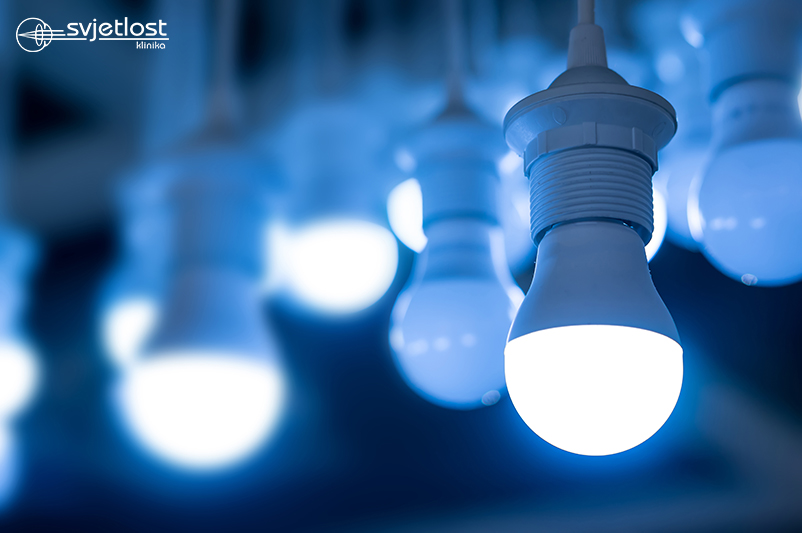Antwort Are LEDs better for your eyes? Weitere Antworten – How can I protect my eyes from LED lights
Use 20-20-20 Rule. The 20-20-20 rule is a great tool for preventing blue light damage and digital eye strain. You should look 20 feet away every 20 minutes for at least 20 seconds. This allows your eyes to take a much-needed break from the harsh light of our devices.warm white
Purchase 'warm white' LED lights: The ANSES report also recommends using LED lights that are 'warm white' rather than 'cool white', as these lights emit less blue light which in turn reduces the potential damage to your eye health.Warm light is best for the eyes. This includes filtered natural light and light produced by incandescent and LED light bulbs. Spread out lighting in your home and workspace to ensure sufficient lighting.
What LED colors don’t hurt your eyes : Studies have shown that warm white or soft white lights in the 2700K-3000K (Kelvin) range can help reduce eye strain and improve sleep quality, making them the perfect choice for cozy reading nooks and bedroom study sessions.
What LED color doesn’t hurt your eyes
Opt for 'Warm White' LED Light
The ANSES report suggests choosing LED lights with a 'warm white' spectrum rather than 'cool white' ones. Warm white LEDs emit lower levels of blue light, which, in turn, reduces the potential risk to your eye health.
What is the healthiest lighting : We suggest using incandescent or halogen bulbs throughout the day + night if you're after a greater sense of well-being. Also – unlike most harshly flickering LED or fluorescent bulbs – incandescents (and color-correct halogens like Chromalux®) will also be the healthiest type of light for your eyes!
Studies have shown that warm white or soft white lights in the 2700K-3000K (Kelvin) range can help reduce eye strain and improve sleep quality, making them the perfect choice for cozy reading nooks and bedroom study sessions.
According to research (and pretty extensive research too) LED lights are bad for eyes. LED lights produce excess high-energy blue light which affects your eyes and health. Despite this, LEDs have become super common for their cost-saving properties.
What is the safest LED light color
When it comes to choosing the right type of LED bulb for use during evening hours, you may want to look for a light bulb designed for circadian health in mind. In general, you will want to look for bulbs that provide more red energy, and less blue energy, in their respective light spectra.Our retina is the part of the eye that absorbs light from our surroundings and allows us to see. According to their report, exposure to powerful LEDs is 'photo-toxic and can lead to irreversible loss of retinal cells. Over time, this may lead to a loss in vision sharpness.Warm light is best for the eyes. This includes filtered natural light and light produced by incandescent and LED light bulbs. Spread out lighting in your home and workspace to ensure sufficient lighting.
Cons of LED Lighting
Blue Hazard and Pollution Risk: The intensity of blue LEDs and cool-white LEDs can exceed safe blue-light hazard limits for eye safety. The cool white LED can also cause more “blue pollution” when used as outdoor lights compared to traditional lighting.
How do LED lights affect the brain : The cells that house melanopsin are particularly sensitive to blue light and melanopsin is fundamental in setting circadian rhythms. Because of this, the effect of blue LEDs is an increase in alertness and interference with sleep patterns in both humans and animals.
What color light is healthiest : Blue light
Blue light is a particularly beneficial part of the light beam, helping to initiate and regulate human circadian rhythms.
Is LED safer than UV
LED bulbs are thought to be safer than UV bulbs, as they transmit weaker rays. With prolonged exposure to LED light (vs. UV light), it is considered not as hazardous, as for example with excessive tanning, which can darken the skin and may lead to skin cancer with prolonged exposure to the sun's UV rays.
LED bulbs are thought to be safer than UV bulbs, as they transmit weaker rays. With prolonged exposure to LED light (vs. UV light), it is considered not as hazardous, as for example with excessive tanning, which can darken the skin and may lead to skin cancer with prolonged exposure to the sun's UV rays.Studies have shown that warm white or soft white lights in the 2700K-3000K (Kelvin) range can help reduce eye strain and improve sleep quality, making them the perfect choice for cozy reading nooks and bedroom study sessions.
Are LED lights bad for face : Studies have shown that the red LED light is typically better than the green one in treating Bowen's disease and also at removing basal cell carcinoma lesions. Generally, LED light therapy is safe when it's used alone without sensitizing medications or creams. LED lights don't damage the skin or skin tissues.




